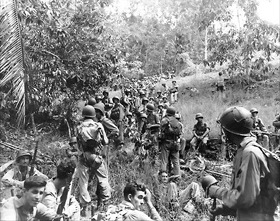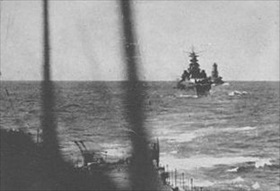FIERCE NAVAL BATTLE OFF GUADALCANAL
Henderson Field, Guadalcanal, Solomon Islands · November 12, 1942
On this date in 1942 in the South Pacific, U.S. and Japanese fleets began the four-day Naval Battle of Guadalcanal, often at point-blank range and under the cover of darkness. Variously referred to as the Third and Fourth Battles of Savo Island, the Battle of the Solomons, or the Battle of Friday the 13th, the Naval Battle of Guadalcanal was the decisive air and sea engagement in a series of naval battles primarily between U.S. and Japanese forces during the monthslong Guadalcanal Campaign in the southern Solomon Islands (August 7, 1942, to February 9, 1943).
Both fleets suffered heavy losses, but losses by the Japanese effectively isolated their Guadalcanal garrison after U.S. pilots from the island’s Henderson Field sank 7 out of 11 resupply transports carrying 7,000 troops, equipment, ammunition, and food. Superior radar equipment allowed the Americans to own the nights, when most of the engagements took place. The Japanese had the better of another night encounter (the Battle of Tassafaronga) in late-November 1942, which was a failed attempt to deliver provisions via floating barrels to their Guadalcanal garrison. However by then the attrition of Japanese naval forces and their Guadalcanal garrison (50 men each day from malnutrition, disease, and Allied ground or air attacks) was so severe that in early January 1943 the Guadalcanal Reinforcement Unit (or “Tokyo Express,” as it was nicknamed by U.S. Marines), finally went into reverse—evacuating rather than resupplying the island. The last of the Japanese garrison was withdrawn in early February 1943.
President Franklin D. Roosevelt, upon learning of the results of the drawn-out Battle for Guadalcanal commented, “It would seem that the turning point in this war has at last been reached.” The continual pressure to reinforce Guadalcanal had weakened Japan’s efforts elsewhere. The Allies’ successful neutralization of Japanese naval and air bases at Rabaul on New Britain facilitated the Southwest Pacific Campaign under Gen. Douglas MacArthur and the Central Pacific island-hopping campaign under Adm. Chester Nimitz, with both efforts successfully advancing toward Japan. The remaining Japanese defenses in the South Pacific were then either destroyed or bypassed by Allied forces as the war progressed to its ultimate conclusion.
[amazon_carousel widget_type=”ASINList” width=”600″ height=”200″ title=”Recommended Reading” market_place=”US” shuffle_products=”False” show_border=”False” asin=”0553386913,141968096X,0553385127,0451238044,0970072147,1591141435,159114146X,1557503273,0252068912,1780961545″ /]
Naval Battle of Guadalcanal, November 12–15, 1942
 |
Above: On August 7, 1942, 20,000 U.S. Marines landed on Guadalcanal, an island roughly 90 miles long and 25 wide, and seized a Japanese airfield at Lunga Point (Lungga Point on the map), later called Henderson Field, before it could become operational. (Henderson Field, on the island’s northern coastline, appears in blue lettering on the map, the airfield as a white diagonal.) In early November 1942 the Japanese organized a transport convoy to ferry 7,000 infantry troops and their equipment to Guadalcanal to retake the airfield. Learning of the Japanese reinforcement effort, U.S. forces launched aircraft and warship attacks to defend Henderson Field and prevent Japanese ground troops from reaching Guadalcanal. The naval battle turned back Japan’s last major attempt to dislodge Allied forces from Guadalcanal. (Note: The ADAIR APA‑91 in the upper left corner of the map refers to the visit of a U.S. Navy attack transport to the island in March 1945.)
 |  |
Left: A large U.S. Marine patrol prepares to move out in pursuit of retreating Japanese during the Guadalcanal Campaign, November 1942. The Battle of Guadalcanal, codenamed Operation Watchtower (August 7, 1942, to February 9, 1943), was the first major offensive by Allied forces against the Empire of Japan. The Allies overwhelmed the outnumbered Japanese defenders, who had occupied the island since May 1942. The Allies suffered 7,100 dead out of 60,000 ground troops. Of more than 36,000 Japanese defenders, about 26,000 were killed or went missing, 9,000 died of disease, and 1,000 were captured. Ships and aircraft lost by both sides were less lopsided.
![]()
Right: Smoke rises from two Japanese planes shot down on November 12, 1942, the first day of the naval battle, as captured in this photo taken aboard the USS President Adams. All air and sea engagements were directly related to a single effort by the Japanese to reinforce their army garrison on Guadalcanal, and are therefore considered to be different parts of the same battle.
 |  |
Left: Japanese warships under Vice Admiral Nobutake Kondō are shown on November 14, 1942, heading for Guadalcanal to bombard Henderson Field after Vice Admiral Hiroaki Abe’s attempt to bombard Henderson Field on the night of November 12/13 failed following a naval engagement. The battleship Kirishima (background) is preceded in formation by the heavy cruiser Takao (center). The new battleship USS Washington, using radar-controlled guns, sank the Kirishima and one destroyer hours after this photo was taken. Just after midnight the Japanese Navy was in retreat, and the attempt to bombard Henderson Field, as well as reinforce the Japanese Guadalcanal garrison, was curtailed.
![]()
Right: Japanese transports Hirokawa Maru and Kinugawa Maru, two of four beached Guadalcanal-bound transports, burn after a failed resupply run to the island on November 15, 1942. Allied dive bombers and torpedo aircraft sank most of the Japanese troop transports, although Japanese escort destroyers managed to rescue many of the men. Only 2,000–3,000 troops made it ashore. Because of the failure to deliver most of the troops and supplies, the Japanese were forced to cancel their planned November offensive on Henderson Field, making the results of the naval battle a significant strategic victory for the Allies and marking the beginning of the end of Japanese attempts to retake Henderson Field.
1955 Film Recounts Battle for Guadalcanal, August 1942 to February 1943
![]()

 History buffs, there is good news! The Daily Chronicles of World War II is now available as an ebook for $4.99 on Amazon.com. Containing a year’s worth of dated entries from this website, the ebook brings the story of this tumultuous era to life in a compelling, authoritative, and succinct manner. Featuring inventive navigation aids, the ebook enables readers to instantly move forward or backward by month and date to different dated entries. Simple and elegant! Click
History buffs, there is good news! The Daily Chronicles of World War II is now available as an ebook for $4.99 on Amazon.com. Containing a year’s worth of dated entries from this website, the ebook brings the story of this tumultuous era to life in a compelling, authoritative, and succinct manner. Featuring inventive navigation aids, the ebook enables readers to instantly move forward or backward by month and date to different dated entries. Simple and elegant! Click 











